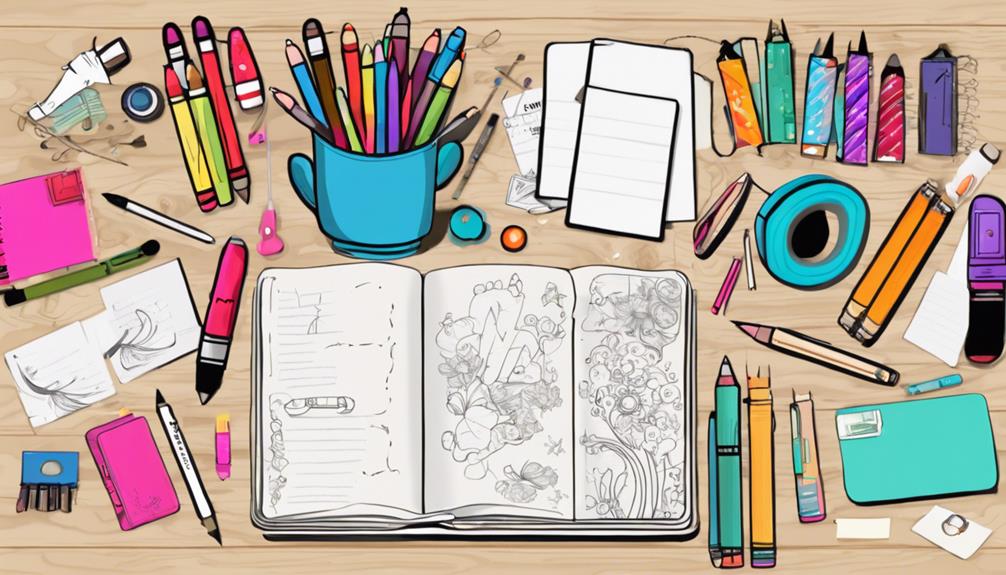Ready to elevate yourself through journaling for self-improvement? Spend just 5-10 minutes daily to access growth. Reflect on childhood memories, set future goals, tackle obstacles, and boost self-awareness. Organize thoughts, track progress, and enhance emotional management. Use tools like Tim Ferris 5-Minute Journal and Habitify to supercharge your journey. Visualize your ideal life, prioritize tasks, tackle issues, and foster personal growth. Embrace gratitude entries, experiment with various styles, and develop a consistent habit for self-awareness. You're on the right track to reveal your full potential through effective journaling techniques!
Key Takeaways
- Reflect on past experiences for self-discovery.
- Set specific goals and track progress.
- Utilize gratitude entries for positivity.
- Experiment with different journaling techniques.
- Consistent daily journaling fosters personal growth.
Daily Growth Journaling Method
Enhance your daily focus, happiness, and self-direction with the simple yet powerful Daily Growth Journaling Method. This method, designed for personal growth journaling, allows you to align your daily priorities with your Purpose and Next Step. By spending just 5-10 minutes each day journaling, you can efficiently organize your thoughts and actions, leading to a more productive and fulfilling life.
The Daily Growth Journaling Method is a quick and effective way to contribute to creating a sense of mastery over life. By setting daily focus items and aligning them with your Purpose and Next Step, you can prioritize tasks and visualize completing them for daily success.
This method guarantees that you stay on track with your goals and aspirations, helping you stay focused, motivated, and aligned with your personal growth journey. Give it a try and see how this simple practice can make a significant difference in your daily life.
Journaling Ideas for Self-Improvement

Hey there, ready to supercharge your self-improvement journey through journaling?
Let's kickstart your progress with some awesome journaling ideas to level up your game.
Get ready for prompts that spark reflection, growth strategies through writing, and visualizing your future success.
Let's crush those goals together!
Prompts for Reflection
Reflecting on various aspects of your past, such as favorite childhood memories and influential adults, can provide valuable insights for personal growth and self-improvement.
By journaling about your childhood memories, you can uncover patterns and behaviors that have shaped your present self. Take time to analyze the impact of influential adults in your life; what lessons did they impart that still resonate with you today?
Through self-reflection and introspection, offer advice to your younger self. Consider what guidance you'd give to navigate challenges or seize opportunities. Evaluate past goals and compare them to your current aspirations.
Are your actions aligned with your desired outcomes? Use these prompts for reflection in your journaling practice to gain a deeper understanding of yourself and foster personal growth.
Embrace the journey of self-discovery as you explore the connections between your past experiences and your present path towards self-improvement.
Growth Through Writing
Engage in journaling practices that focus on productivity planning, progress tracking, and mental clarity to drive your personal growth and self-improvement journey. By incorporating daily reflection, goal setting, and problem-solving techniques in your journaling routine, you can make significant strides in personal development. Utilizing tools like the Tim Ferris 5-Minute Journal and Habitify can boost your productivity, self-awareness, and habit-building efforts, propelling you towards your goals.
| Journaling Ideas for Self-Improvement | Benefits |
|---|---|
| Daily journaling | Enhances self-awareness |
| Mental clarity | Improves focus and decision-making |
| Goal setting | Guides progress and growth |
Focusing your journaling on self-reflection and goal-directed methods can also enhance emotional management, mindfulness, and overall well-being. Through this process, you'll find yourself better equipped to handle challenges and foster personal growth. So, grab your journal and start writing your way to a better you!
Visualizing Future Success
Imagine your future success through journaling by envisioning your ideal life in 15-20 years. Setting specific goals is essential to work towards this envisioned future. This practice of visualizing future success can greatly contribute to your personal growth and self-improvement journey.
Take time in your journal to assess your current life direction. Identify the changes you desire and imagine your dream daily routine. By doing so, you can create a roadmap for achieving your goals. Reflect on the gaps between your current reality and your envisioned future. Address any obstacles and limiting beliefs that may impede your progress.
Setting future goals for different timeframes, such as 1 year, 5 years, and 10 years ahead, will help you outline steps for personal growth. Include plans for enhancing physical and mental health, as well as pushing yourself out of your comfort zone.
Embrace the power of journaling to visualize and manifest the successful future you aspire to achieve.
Focus and Reflection Through Journaling

Prioritize your daily tasks and enhance self-awareness through journaling by setting focus items and capturing reflections. By incorporating a journaling practice into your routine, you can boost productivity and foster personal growth.
Start by jotting down your daily focus items the night before. This simple act not only helps you organize your thoughts but also sets a clear direction for the day ahead, allowing you to tackle tasks with purpose.
As you go about your day, make sure to take a few moments to reflect on your progress and capture your thoughts in your journal. This practice not only enhances self-awareness but also serves as a valuable tool for documenting your achievements and areas for improvement.
Periodically revisiting your journal entries allows for thorough reflection, enabling you to track your personal growth over time.
Self-Reflection and Problem-Solving

Reflecting on your thoughts and experiences through journaling can't only enhance your self-awareness but also provide a structured approach to problem-solving. By engaging in self-reflection, you commence on a journey of personal growth and discovery.
Through introspection, you gain insights into your emotions, behaviors, and thought patterns, which in turn can boost your emotional intelligence. Journaling serves as a tool to help you navigate through challenges by defining issues clearly, brainstorming potential solutions, and outlining actionable steps towards improvement.
As you jot down your reflections, you begin to unravel the layers of your inner self, uncovering hidden beliefs and values that shape your decision-making process. This deeper level of introspection not only enhances your self-awareness but also equips you with the necessary tools to tackle obstacles more effectively.
Utilizing Journaling Techniques

Hey, you! Ready to supercharge your self-improvement journey through journaling techniques?
Let's talk about an overview of these techniques, practical tips for application, and how you can personalize your journaling approach for maximum effectiveness.
Get ready to level up your self-reflection game with these powerful tools!
Journaling Techniques Overview
Journaling techniques encompass various methods such as gratitude entries, reflection on past experiences, meticulous planning, deep questioning, and regular journaling for focus, all aimed at enhancing self-improvement.
These techniques help in creating emotional distance for clearer thinking, providing fresh perspectives, and enhancing mental clarity. Utilizing different journaling formats and methods can aid in stress reduction, improved problem-solving skills, and overall well-being.
Techniques like gratitude entries and reflection on daily accomplishments can boost self-esteem, memory, and cognitive abilities. Experimenting with various journaling styles and prompts can lead to enhanced self-awareness, personal growth, and effective self-improvement.
- Gratitude entries: Foster positivity and appreciation in daily life.
- Reflection on past experiences: Gain insights, learn from mistakes, and celebrate achievements.
- Meticulous planning: Organize thoughts, set goals, and track progress effectively.
Practical Application Tips
To effectively apply journaling techniques for self-improvement, consider experimenting with various prompts and tools to enhance personal growth. Try different journaling methods such as gratitude entries, reflection on past experiences, meticulous planning, and deep questioning to deepen your self-understanding and boost productivity.
Utilize prompts like question-of-the-day journals or 5-minute elevation journaling ideas to facilitate introspection and authentic expression. Incorporate productivity tools such as the Tim Ferris 5-Minute Journal, Habitify for Better Habits, and Bullet Journaling to improve goal achievement and self-awareness.
Developing a consistent journaling habit is key to reaping the benefits of increased gratitude, acknowledging achievements, and effectively maneuvering challenges. Ensure your journaling practice prioritizes self-reflection, encourages authentic expression, and maintains a level of privacy to optimize its impact on your journey of self-improvement.
Personalized Journaling Approaches
Experiment with personalized journaling approaches by incorporating various techniques and tools to tailor your self-improvement journey effectively.
When it comes to journaling, there are several unique methods you can try:
- Question-of-the-day Journaling: Dedicate time daily to reflect deeply on a personal question to enhance self-awareness and growth.
- 5-Minute Elevation Journaling: Spend just 5 minutes each day focusing on positive thoughts to boost your mood, self-esteem, and overall positivity.
- Tim Ferris' 5-Minute Journal Method: Follow Tim Ferris' approach to elevate your mood, improve mental health, and develop a more positive outlook when facing challenges.
Tools for Effective Journaling

Enhancing your journaling experience can be achieved through utilizing various tools designed to promote self-improvement and productivity. Tools like the Tim Ferris 5-Minute Journal can elevate your mood and contribute to better mental health.
Habitify is another useful tool that aids in building better habits, leading to self-improvement by enhancing efficiency and self-awareness.
Starting a journal not only sharpens your mind but also boosts productivity and increases self-awareness. If you prefer a more structured approach, bullet journaling can help enhance organization and effectiveness in achieving your goals.
Various guides are available to assist you in starting both traditional and bullet journals, ensuring that you have the necessary support to kickstart your journaling journey.
Frequently Asked Questions
How to Write a Self-Growth Journal?
To write a self-growth journal, find a quiet space, choose paper or digital, and start with short daily sessions. Use prompts for inspiration and write freely without worrying about grammar. Encourage authentic self-expression.
How Does Journaling Help With Self-Improvement?
Journaling boosts self-improvement by enhancing self-awareness and identifying patterns in behavior. It helps reframe negative thoughts, track progress, and set goals. Celebrate successes and reflect on values for personal growth. It's a powerful tool!
How to Write in Your Journal to Improve Yourself and Achieve Your Goals?
To improve yourself and achieve goals, jot down reflections, set intentions, and track progress in your journal. Try gratitude entries, daily reflections, and visualization techniques. Make journaling a habit for self-awareness and personal growth.
What Is Growth Journaling?
Growth journaling is your personal compass for self-improvement. It's about reflecting, setting goals, and tracking progress. Find patterns, strengths, and areas for growth. Visualize goals, explore values, and nurture mindfulness for a better you.
What Are the Most Effective Journaling Techniques for Self-Improvement and Growth?
When it comes to selfimprovement journal maintenance, there are several effective techniques for self-improvement and growth. Some of the most popular methods include daily gratitude journaling, reflection on personal challenges and successes, setting achievable goals, and practicing self-compassion. These techniques can help individuals track their progress and cultivate a positive mindset.
Can Effective Journaling for Self-Improvement Lead to Profitable Blogging?
Effective journaling for self-improvement can lay the foundation for a profitable blogging venture. By sharing personal growth experiences and insights, bloggers can attract a dedicated audience interested in the topic of self-improvement, thereby monetizing selfimprovement blogs profit through affiliate marketing, sponsored content, or digital product sales.
Conclusion
To sum up, journaling is a powerful tool for personal growth and self-improvement. By consistently writing in your journal, you can enhance your focus, reflect on your thoughts and experiences, and develop effective problem-solving skills.
Remember, journaling isn't just about writing down your thoughts, but also about taking action and making positive changes in your life. So grab your pen and paper, and start journaling your way to a better you!
As they say, "The pen is mightier than the sword."










